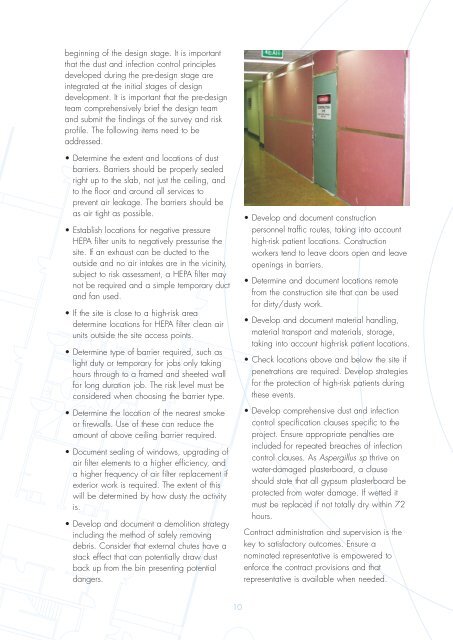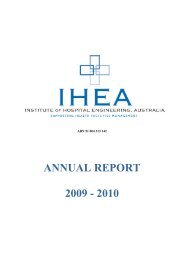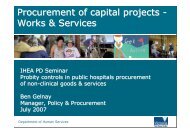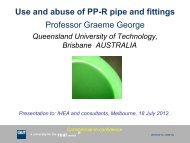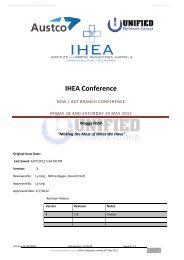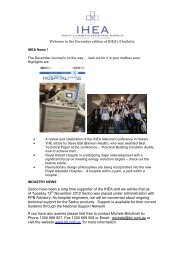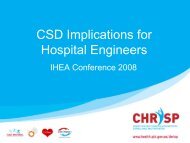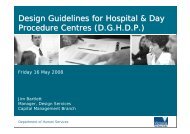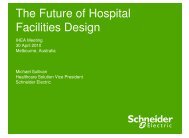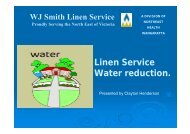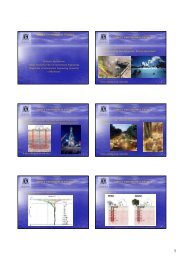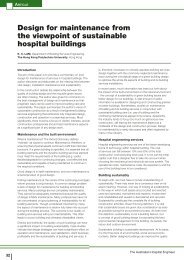Infection Control Principles for the Management of Construction ...
Infection Control Principles for the Management of Construction ...
Infection Control Principles for the Management of Construction ...
Create successful ePaper yourself
Turn your PDF publications into a flip-book with our unique Google optimized e-Paper software.
eginning <strong>of</strong> <strong>the</strong> design stage. It is important<br />
that <strong>the</strong> dust and infection control principles<br />
developed during <strong>the</strong> pre-design stage are<br />
integrated at <strong>the</strong> initial stages <strong>of</strong> design<br />
development. It is important that <strong>the</strong> pre-design<br />
team comprehensively brief <strong>the</strong> design team<br />
and submit <strong>the</strong> findings <strong>of</strong> <strong>the</strong> survey and risk<br />
pr<strong>of</strong>ile. The following items need to be<br />
addressed.<br />
• Determine <strong>the</strong> extent and locations <strong>of</strong> dust<br />
barriers. Barriers should be properly sealed<br />
right up to <strong>the</strong> slab, not just <strong>the</strong> ceiling, and<br />
to <strong>the</strong> floor and around all services to<br />
prevent air leakage. The barriers should be<br />
as air tight as possible.<br />
• Establish locations <strong>for</strong> negative pressure<br />
HEPA filter units to negatively pressurise <strong>the</strong><br />
site. If an exhaust can be ducted to <strong>the</strong><br />
outside and no air intakes are in <strong>the</strong> vicinity,<br />
subject to risk assessment, a HEPA filter may<br />
not be required and a simple temporary duct<br />
and fan used.<br />
• If <strong>the</strong> site is close to a high-risk area<br />
determine locations <strong>for</strong> HEPA filter clean air<br />
units outside <strong>the</strong> site access points.<br />
• Determine type <strong>of</strong> barrier required, such as<br />
light duty or temporary <strong>for</strong> jobs only taking<br />
hours through to a framed and sheeted wall<br />
<strong>for</strong> long duration job. The risk level must be<br />
considered when choosing <strong>the</strong> barrier type.<br />
• Determine <strong>the</strong> location <strong>of</strong> <strong>the</strong> nearest smoke<br />
or firewalls. Use <strong>of</strong> <strong>the</strong>se can reduce <strong>the</strong><br />
amount <strong>of</strong> above ceiling barrier required.<br />
• Document sealing <strong>of</strong> windows, upgrading <strong>of</strong><br />
air filter elements to a higher efficiency, and<br />
a higher frequency <strong>of</strong> air filter replacement if<br />
exterior work is required. The extent <strong>of</strong> this<br />
will be determined by how dusty <strong>the</strong> activity<br />
is.<br />
• Develop and document a demolition strategy<br />
including <strong>the</strong> method <strong>of</strong> safely removing<br />
debris. Consider that external chutes have a<br />
stack effect that can potentially draw dust<br />
back up from <strong>the</strong> bin presenting potential<br />
dangers.<br />
• Develop and document construction<br />
personnel traffic routes, taking into account<br />
high-risk patient locations. <strong>Construction</strong><br />
workers tend to leave doors open and leave<br />
openings in barriers.<br />
• Determine and document locations remote<br />
from <strong>the</strong> construction site that can be used<br />
<strong>for</strong> dirty/dusty work.<br />
• Develop and document material handling,<br />
material transport and materials, storage,<br />
taking into account high-risk patient locations.<br />
• Check locations above and below <strong>the</strong> site if<br />
penetrations are required. Develop strategies<br />
<strong>for</strong> <strong>the</strong> protection <strong>of</strong> high-risk patients during<br />
<strong>the</strong>se events.<br />
• Develop comprehensive dust and infection<br />
control specification clauses specific to <strong>the</strong><br />
project. Ensure appropriate penalties are<br />
included <strong>for</strong> repeated breaches <strong>of</strong> infection<br />
control clauses. As Aspergillus sp thrive on<br />
water-damaged plasterboard, a clause<br />
should state that all gypsum plasterboard be<br />
protected from water damage. If wetted it<br />
must be replaced if not totally dry within 72<br />
hours.<br />
Contract administration and supervision is <strong>the</strong><br />
key to satisfactory outcomes. Ensure a<br />
nominated representative is empowered to<br />
en<strong>for</strong>ce <strong>the</strong> contract provisions and that<br />
representative is available when needed.<br />
10


